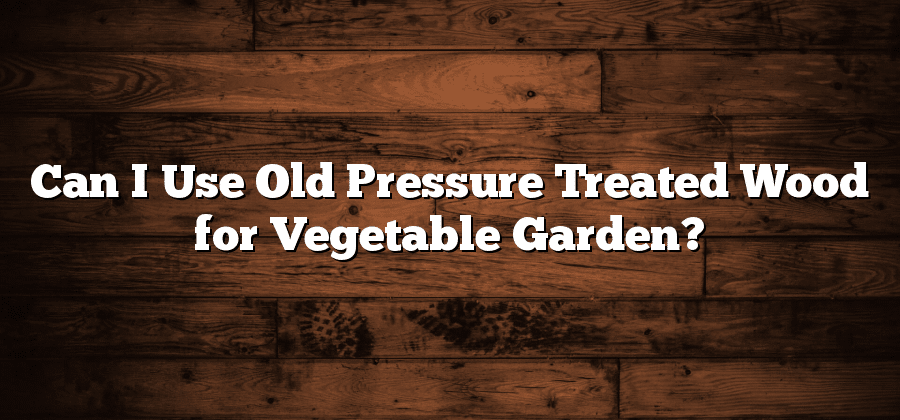Risks of Using Old Pressure Treated Wood
Old pressure treated wood may seem like a cost-effective option for building projects, but it comes with its fair share of risks. One of the main concerns is the potential for chemical leaching. Pressure treated wood is treated with chemicals such as chromated copper arsenate (CCA) to protect it from rot and insect damage. Over time, these chemicals can seep into the surrounding soil and water, posing a risk to both human and environmental health.
Exposure to these chemicals can have adverse effects on human health. Studies have linked CCA-treated wood to various health issues, including respiratory problems, skin irritation, and even certain types of cancer. Children, in particular, are more vulnerable to the harmful effects of these chemicals due to their smaller size and still-developing immune systems. Additionally, the chemicals can accumulate in the food chain, affecting the quality and safety of vegetables grown in contaminated soil.
Effects of Chemicals on Vegetables
When it comes to growing vegetables, ensuring their safety and quality is of utmost importance. One crucial aspect to consider is the potential effects of chemicals on these edible plants. Chemicals, such as those present in old pressure treated wood or other sources, have the potential to seep into the soil and pose a risk to vegetables. These chemicals can be absorbed by the plant’s roots and transported to various parts of the plant, including the leaves and edible portions. Given that many people rely on homegrown vegetables for their daily nutrition, it becomes essential to understand and address the potential implications of chemicals on these crops.
The effects of chemicals on vegetables can vary depending on various factors, such as the type and concentration of chemicals involved, the duration of exposure, and the specific vegetable variety. Some chemicals may interfere with the plant’s growth and development, leading to stunted or malformed vegetables. In other cases, chemicals could contaminate the edible parts of the plant, increasing the risk of human consumption of toxic substances. Additionally, the presence of chemicals in vegetable gardens can have long-term consequences on soil health and overall ecosystem balance. Understanding these potential effects can help guide gardeners and farmers in making informed decisions and implementing strategies to ensure the safety and quality of their vegetables.
• Chemicals present in old pressure treated wood or other sources can seep into the soil and pose a risk to vegetables.
• These chemicals can be absorbed by the plant’s roots and transported to various parts of the plant, including the leaves and edible portions.
• Some chemicals may interfere with the plant’s growth and development, leading to stunted or malformed vegetables.
• Chemicals could contaminate the edible parts of the plant, increasing the risk of human consumption of toxic substances.
• The presence of chemicals in vegetable gardens can have long-term consequences on soil health and overall ecosystem balance.
Considerations for Vegetable Garden Safety
When it comes to maintaining a safe vegetable garden, there are several important considerations to keep in mind. First and foremost, it is crucial to be mindful of the type of materials used in the garden, particularly when it comes to the construction of raised beds or planters. One common concern is the use of old pressure treated wood, which may contain harmful chemicals such as arsenic or chromium. These chemicals can leach into the soil over time, posing a potential risk to both the plants and those who consume them.
To ensure vegetable garden safety, it is recommended to explore alternatives to old pressure treated wood. There are now various options available, such as naturally rot-resistant woods like cedar or redwood, or composite materials made from recycled plastic and wood fibers. These alternatives not only provide a safer option for gardening, but they also have the added benefit of being more sustainable, reducing the overall environmental impact. By choosing these materials, gardeners can minimize the risk of chemical exposure and create a safer, healthier growing environment for their vegetables.
Alternatives to Old Pressure Treated Wood
One alternative to using old pressure treated wood is to opt for naturally resistant wood species. Certain types of wood, such as cedar, redwood, and cypress, have natural resistance to decay, insects, and rot. These woods are known for their durability and longevity, making them a safe and sustainable choice for outdoor projects.
Another alternative is to use plastic or composite lumber. These materials are made from recycled plastics and other durable components, providing a long-lasting and environmentally friendly option. Plastic lumber does not require any chemical treatments and is resistant to rot, insects, and weathering. Composite lumber, which is made from a combination of wood fibers and recycled plastics, offers the look and feel of real wood without the risk of chemical leaching. These alternatives provide a safer and more sustainable option for outdoor construction projects.
Testing for Chemical Residue in Wood
It is essential to thoroughly test for chemical residue in wood before using it for any construction or gardening purposes. Chemical treatments, such as those used in pressure treated wood, can be harmful to human health and the environment. Testing for chemical residue is an important step to ensure the safety and sustainability of our projects.
One method for testing chemical residue in wood is called leaching. This involves soaking the wood in water and analyzing the runoff for any chemicals present. Another test is the use of special solvents to extract the chemicals from the wood and measure their concentration. These tests can help determine if the wood contains any harmful substances and if it is suitable for your intended use. It is crucial to conduct these tests, especially when dealing with older pressure treated wood that might have higher levels of chemicals.






